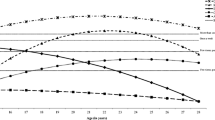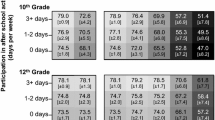Abstract
Researchers have found mixed support for documenting whether work is protective or harmful during adolescence. This study examined the association between work and problem behaviors among African American youth (N = 592; 53% female; M = 14.8 years, SD = .60) followed from mid-adolescence to young adulthood over eight Waves (90% response rate over the first four Waves and a 68% response rate across all eight Waves). We explored three competing operationalizations of work: work history (never worked, worked), work intensity (no work, 20 h or less, and 21 h or over), and work trajectories (never worked, episodic work, stopped working, late starter, and consistent worker). Non-working youth reported higher marijuana use during young adulthood than their working counterparts. Nonworkers reported lower self-acceptance during young adulthood than those working greater number of hours per week. Differences in work trajectories for cigarette use, depression, and anxiety during adolescence imply that when and for how long youth work are also important factors to explore. Our findings lend tentative support to the work benefits perspective and suggest that the association between work and problem behaviors may depend on the work measure used. We discuss the implications of employing different work measures in adolescent research.





Similar content being viewed by others
References
Bachman, J. G., & Schulenberg, J. (1993). How part-time work intensity relates to drug use, problem behavior, time use, and satisfaction among high school seniors: are these consequences or merely correlates? Developmental Psychology, 29(2), 220–235.
Bjarnason, T., & Sigurdardottir, T. J. (2003). Psychological distress during unemployment and beyond: social support and material deprivation among youth in six northern European countries. Social Science & Medicine, 56, 973–985.
Cohen, S., Kamarck, T., & Mermelstein, R. (1983). A global measure of perceived stress. Journal of Health and Social Behavior, 24, 385–396.
Crichton, N. (2000). Information point: Wilks’ lambda. Journal of Clinical Nursing, 9, 381.
Derogatis, L.R., & Spencer, P.M. (1982). Brief Symptom Inventory: Administration, scoring, and procedure manual. Baltimore: Clinical Psychometric Research.
Ellickson, P.L., Orlando, M., Tucker, J.S., & Klein, D.J. (2004). From adolescence to young adulthood: Racial/ethnic disparities in smoking. American Journal of Public Health, 94(2), 293–300.
Galambos, N. L., Barker, E. T., & Tilton-Weaver, L. C. (2003). Who gets caught at maturity gap? A study of pseudomature, immature, and mature adolescents. International Journal of Behavioral Development, 27, 253–263.
Graber, J. A. (2004). Internalizing Problems during Adolescence. In R. M. Lerner & L. Steinberg (Eds.), Handbook of adolescent psychology (2nd ed., pp. 587–626). Hoboken, New Jersey: John Wiley & Sons, Inc.
Greenberger, E., & Steinberg, L. (1986). When teenagers work: The psychological and social costs of adolescent employment. New York: Basic Books.
Hirsch, B. J., & DuBois, D. L. (1991). Self-esteem in early adolescence: The identification and prediction of contrasting longitudinal trajectories. Journal of Youth and Adolescence, 20(1), 53–72.
Irwin, C.E., Burg, S.J., & Uhler-Cart, C. (2002). America’s Adolescents: Where have we been, where are we going? Journal of Adolescent Health, 31, 91–121.
Johnson, M. K. (2004). Further evidence on adolescent employment and substance use: Differences by race and ethnicity. Journal of Health and Social Behavior, 45(2), 187–197.
Kegler, M. C., Oman, R. F., Vesely, S. K., McLeory, K. R., Aspy, C. B., & Rodine, S., & Marshall, L. (2005). Relationships among youth assets and neighborhood and community resources. Health Education & Behavior, 32(3), 380–397.
Lewis, M. (1999). Contextualism and the issue of continuity. Infant Behavior and Development, 22, 431–444.
Morrell, S., Taylor, R., Quine, S., Kerr, C., & Western, J. (1999). A case-control study of employment status and mortality in a cohort of Australian youth. Social Science & Medicine, 49, 383–392.
Mortimer, J.T. (2003). Work and growing up in America. Cambridge, MA: Harvard University Press.
Mortimer, J. T., Finch, M., Shanahan, M. J., & Ryu, S. (2000). Work experience, mental health, and behavioral adjustment in adolescence. In G. Adams (Ed.), Adolescent development: The essential readings (pp. 190–222). Oxford: Blackwell Publishers.
Mortimer, J. T., Harley, C., & Staff, J. (2002). The Quality of Work and Youth Mental Health. Work and occupations, 29(2), 166–197.
Paschall, M. J., Flewelling, R. L., & Russell, T. (2004). Why is work intensity associated with heavy alcohol use among adolescents? Journal of Adolescent Health, 34, 79–87.
Raphael, S. (1998). The spatial mismatch hypothesis and Black youth joblessess: Evidence from the San Francisco Bay Area. Journal of Urban Economics, 43, 79–111.
Resnick, M. D., Bearman, P. S., Blum, R. W., Bauman, K. E., Harris, K. M., Jones, J., et al. (1997). Protecting adolescents from harm: Findings from the National Longitudinal Study on Adolescent Health. Journal of the American Medical Association, 278(10), 823–832.
Safron, D., Schulenberg, J., & Bachman, J. G. (2001). Part time work and hurried adolescence: the links among work intensity, social activities, health behaviors, and substance use. Journal of Health and Social Behavior, 42(4), 425–429.
Shanahan, M. J., Finch, M., Mortimer, J. T., & Ryu, S. (1991). Adolescent work and depressive affect. Social Psychology Quarterly, 54(4), 299–317.
Shanahan, M. J., Mortimer, J. T., & Kruger, H. (2002). Adolescence and adult work in the twenty-first century. Journal of Research on Adolescence, 12(1), 99–120.
Schulenberg, J., Maggs, J. L., & O’Malley, P. M. (2003). How and why the understanding of developmental continuity and discontinuity is important: THe sample case of long-term consequences of adolescent substance use. In J. T. Mortimer & M. J. Shanahan (Eds.), Handbook of the life course (pp. 413–436). New York: Kluwer Academic/Plenum Publishers.
Schulenberg, J., Wadsworth, K. N., O’Malley, P. M., Bachman, J. G., & Johnston, L. D. (1996). Adolescent risk factors for binge drinking during the transition to young adulthood: variable- and pattern-centered approaches to change. Developmental Psychology, 32(4), 659–674.
Staff, J., Mortimer, J. T., & Uggen, C. (2004). Work and Leisure in Adolescence. In R. M. Lerner & L. Steinberg (Eds.), Handbook of adolescent psychology (2nd ed., pp. 429–450). Hoboken, New Jersey: John Wiley & Sons, Inc.
Stein, J. A., Newcomb, M. D., & Bentler, P. M. (1986). Stability and change in personality: A longitudinal study from early adolescence to young adulthood. Journal of Research in Personality, 20, 276–291.
Steinberg, L., & Dornbusch, S. M. (1991). Negative correlates of part-time employment during adolescence: Replication and elaboration. Developmental Psychology, 27(2), 304–313.
Steinberg, L., Fegley, S., & Dornbusch, S. M. (1993). Negative impact of part-time work on adolescent adjustment: Evidence from a longitudinal study. Developmental Psychology, 29(2), 171–180.
Swanson, D. P., Spencer, M. B., & Petersen, A. (1998). Identity formation in adolescence. In: K. Borman & B. Schneider (Eds.), The adolescent years: Social influences and educational challenges (pp. 18–41). Chicago: The University of Chicago Press.
Takeuchi, D. T., & Williams, D. R. (2003). Race, ethnicity, and mental health: Introduction to the Special Issue. Journal of Health and Social Behavior, 44(3), 233–236.
U.S. Department of Labor—Bureau of Labor Statistics (2004). The Employment Situation: June 2004. Accessed from the World Wide Web on July 8, 2004 at http://www.bls.gov/news.release/pdf/empsit.pdf
Valois, R. F., Dunham, A. C. A., Jackson, K. L., & Waller, J. (1999). Association between employment and substance abuse behaviors among public high school adolescents. Journal of Adolescent Health, 25, 256–263.
Weller, N. F., Kelder, S. H., Cooper, S. P., Basen-Engquist, K., & Tortolero, S. R. (2003). School-year employment among high school students: Effects on academic, social, and physical functioning. Adolescence, 38(151), 441–458.
Zimmerman, M. A., Caldwell, C. H., & Bernat, D. H. (2002). Discrepancy between self-report and school-record grade point average: Correlates with psychosocial outcomes among African American adolescents. Journal of Applied Social Psychology, 32(1), 86–109.
Zimmerman, M. A., Copeland, L. A., Shope, J. T., & Dielman, T. E. (1997). A longitudinal study of self-esteem: Implications for adolescent development. Journal of Youth and Adolescence, 26(2), 117–142.
Acknowledgements
This research was supported by a grant from the National Institute of Drug Abuse to the University of Michigan—School of Public Health (Grant Number R01- DA07484; Principal Investigator: Marc A. Zimmerman, Ph.D.) and a center grant from the National Institute of Mental Health to the HIV Center for Clinical and Behavioral Studies at NY State Psychiatric Institute and Columbia University (P30-MH43520; Principal Investigator, Anke A. Ehrhardt, Ph.D.).
Author information
Authors and Affiliations
Corresponding author
Rights and permissions
About this article
Cite this article
Bauermeister, J.A., Zimmerman, M.A., Barnett, T.E. et al. Working in High School and Adaptation in the Transition to Young Adulthood among African American Youth. J Youth Adolescence 36, 877–890 (2007). https://doi.org/10.1007/s10964-007-9196-0
Received:
Accepted:
Published:
Issue Date:
DOI: https://doi.org/10.1007/s10964-007-9196-0




